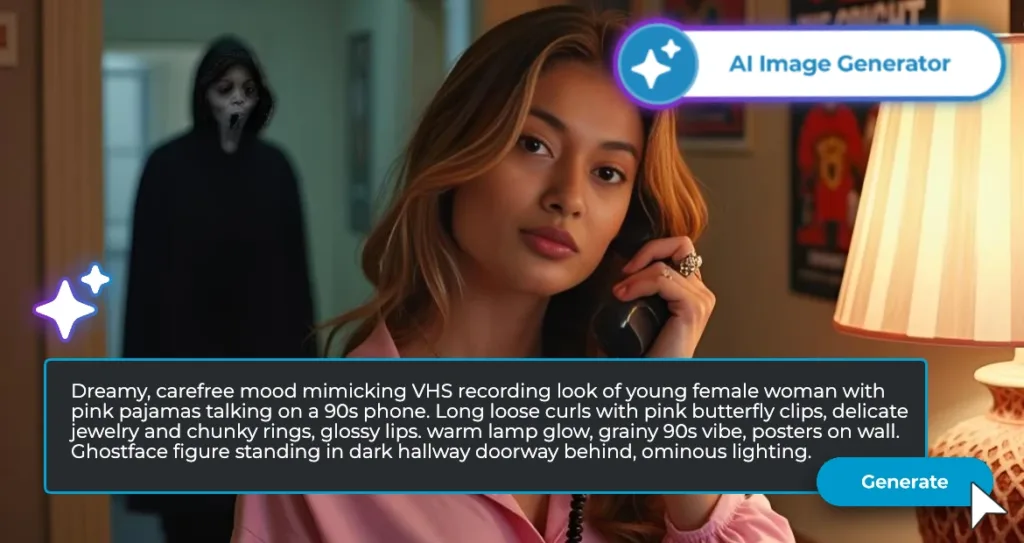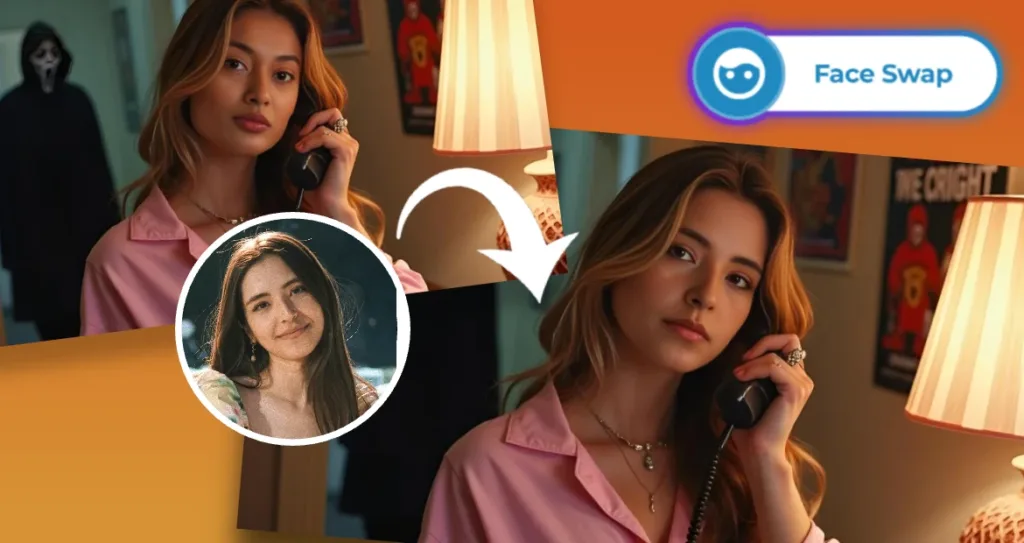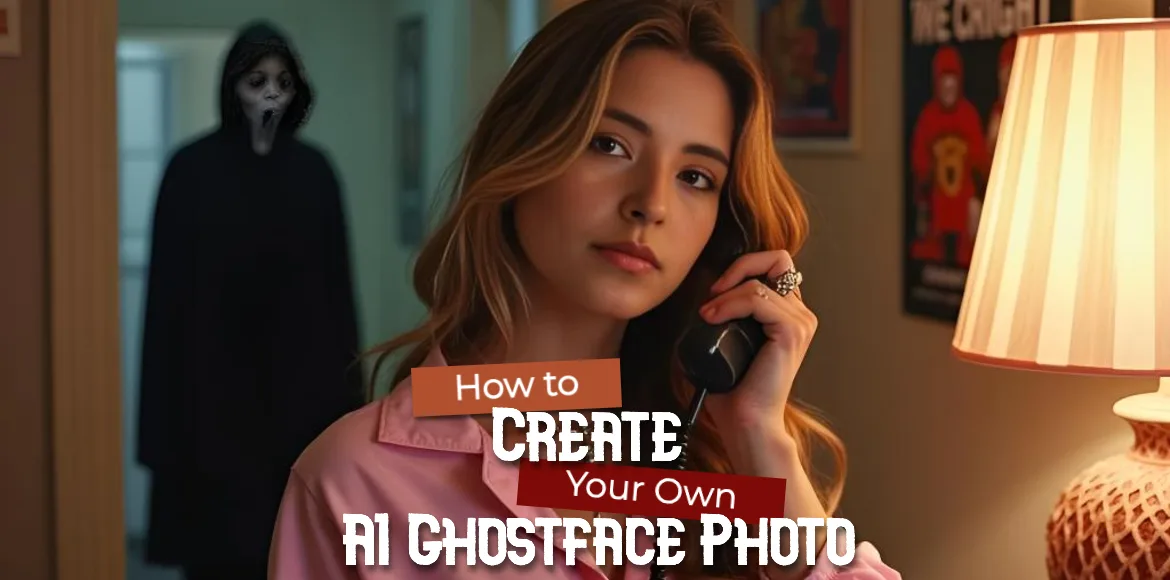Create the Viral AI Ghostface Look in Seconds with Pixlr
Halloween came early this year—with AI Ghostface lurking just beyond your bedroom doorway, watching silently as you lounge on pink satin sheets, lost in a Y2K daydream. What started as a nostalgic wink to the Scream franchise has exploded into one of the most viral AI horror trends of the season, sweeping across TikTok, Instagram, and beyond.
Fueled by the rise of accessible generative AI, users are crafting eerily realistic scenes that blend 90s bedroom aesthetics with spine-chilling suspense—all with a single text prompt. This wave of scary AI creativity taps into our love for cinematic thrills and digital self-expression, making AI-generated content not just a novelty but a new form of storytelling. While some platforms rely on external apps or raise concerns about AI deepfakes, Pixlr offers a safe, all-in-one creative suite right in your browser. With Pixlr’s AI Image Generator, AI FaceSwap, and AI Video Generator, you can bring your own scream-inspired thriller to life—no downloads, no data risks, and zero coding required. Whether you’re crafting a still image or a mini AI short film, Pixlr puts the power (and the popcorn) in your hands.
Why the AI Ghostface Trend Is Taking Over
The AI Ghostface trend is more than just a passing social media fad. It captures a unique cultural moment where nostalgia for Y2K and 90s aesthetics meets the explosive rise of accessible AI creativity. At its heart, the trend draws on our collective longing for the dreamy, intimate visuals of the late 90s and early 2000s: pink satin bedding, butterfly clips, chunky rings, grainy film effects, and bedroom walls covered in posters. Now, with the help of generative AI, users can step directly into that world, but with a sinister surprise waiting in the shadows.
This trend also reflects a natural progression in how people are using AI for self-expression. Earlier in the year, feeds were filled with soft, whimsical AI box doll avatars, pastel-toned, stylized versions of oneself that leaned into fantasy and innocence. The AI Ghostface phenomenon flips that idea on its head, replacing sweetness with suspense. Instead of cute portraits, users are now crafting cinematic horror scenes that feel like stills from an AI thriller. It is no longer just about how you look. It is about mood, narrative, and atmosphere. Each image becomes a mini AI short film frozen in time.
Importantly, this trend emphasizes user control and creative safety. Unlike AI deepfake tools, which often manipulate real videos of people without consent and raise serious ethical concerns, the AI Ghostface trend relies on text-to-image generation and artistic reinterpretation. You are not altering real footage of someone else. You are building a fictional scene from the ground up and inserting a stylized version of yourself into a cinematic moment. Platforms like Pixlr support this by offering transparent, privacy-conscious tools that keep creation in the user’s hands, with no hidden data use or deceptive face-swapping.
In a broader context, this surge is tied to the growing role of AI in entertainment. From indie creators producing AI horror shorts to studios experimenting with AI video generators, the boundaries between audience and creator are dissolving. The Ghostface trend is a grassroots example of that shift: anyone with a prompt can become a director, set designer, and lead actor all at once.
And best of all, it is playful, highly shareable, and just spooky enough to thrill without crossing into real fear. That is why it is not just trending. It is taking over.
Your AI Ghostface Prompt: The Perfect Recipe
Creating your own AI Ghostface image starts with the right prompt. This carefully crafted description gives the AI clear, vivid instructions to generate a scene that’s equal parts nostalgic, glamorous, and chilling. Below is the full prompt you can copy and paste directly into Pixlr’s AI Image Generator:
Let’s break down why this prompt works so well:

- Y2K Bedroom Details
The setting is pure late-90s nostalgia: shiny pink satin sheets, a warm bedside lamp casting a soft glow, and vintage posters on the wall. The grainy film effect adds authenticity, mimicking the look of old disposable cameras or VHS recordings.

2. Character Styling
The woman in the scene is styled like a Y2K icon: long loose curls, delicate gold necklaces, and bold chunky rings. Her glossy lips and relaxed pose with a pink corded phone evoke a dreamy, carefree mood, like she’s lost in a late-night chat with a friend. This soft, feminine aesthetic contrasts sharply with what’s lurking behind her.

3. Horror Element
Ghostface stands silently in the dark hallway, just visible in the background. The lighting around him is dim and ominous, creating tension without overwhelming the main subject. He’s not front and center but he’s watching. That subtle placement is what makes the image feel like a still from a real AI horror movie.
Why This Prompt Is Perfect for AI Horror Storytelling
This prompt masterfully blends two moods: the warmth and innocence of a Y2K bedroom with the cold dread of a slasher film. That contrast is exactly what makes AI-generated horror so compelling—it’s not just scary, it’s cinematic. By combining everyday nostalgia with a hidden threat, the image tells a story in a single frame, making it ideal for AI short films, social content, or creative experiments with AI animation and AI-powered image generation.
And the best part? You can easily customize it. Swap pink bedding for baby blue, add a bowl of popcorn, or include a chewing gum bubble for extra personality—all while keeping that perfect balance of glamour and suspense.
How to Create Your AI Ghostface Image with Pixlr
Creating your own AI Ghostface image has never been easier or more fun. With Pixlr’s AI tools, you can turn an idea into a shareable horror masterpiece in a few clicks with no downloads, no complicated software, and no need to leave your browser. Use this simple step by step guide to join the Ghostface AI trend safely and creatively.

Step 1: Generate the Base Scene with AI Image Generator
Go to Pixlr’s AI Image Generator. This powerful tool turns your words into vivid visuals using advanced text to image technology. Paste the full AI Ghostface prompt, then select Generate.
Prompt:
Dreamy, carefree mood mimicking VHS recording look of young female woman with pink pajamas talking on a 90s phone. Long loose curls with pink butterfly clips, delicate jewelry and chunky rings, glossy lips. warm lamp glow, grainy 90s vibe, posters on wall. Ghostface figure standing in dark hallway doorway behind, ominous lighting
For best results, choose a 9×16 vertical aspect ratio if you plan to post on TikTok or Instagram Reels. Add keywords such as grainy film, 90s VHS, or soft lamp lighting to create a nostalgic cinematic feel. In seconds, you will have a dreamy Y2K bedroom scene with a chilling surprise in the background.

Step 2: Swap in Your Face Using AI FaceSwap
Now it’s time to make the image truly yours. Open Pixlr’s AI FaceSwap tool and upload two images, a clear, well-lit forward-facing selfie and the AI-generated bedroom scene.
The tool maps your facial features onto the Y2K character in the image. The AI matches the lighting in your selfie to the lamp glow in the scene to avoid harsh shadows or mismatched tones. This step adds a personal, immersive twist. It is not just any girl in a bedroom, it is YOU, blissfully unaware as Ghostface watches from the hallway. Enjoy safe, user-controlled AI face swap technology for a realistic Ghostface AI effect.
Step 3: Animate It with AI Video Generator
Bring your scene to life with Pixlr’s AI Video Generator. Upload your final AI Ghostface image and add subtle motion to create a mini AI short film.
You can animate elements like
– Curtains gently fluttering in the breeze
– The phone cord swaying as you shift on the bed
– Ghostface slowly stepping forward in the dark hallway
With Pixlr AI Video Generator Ultra mode, audio is supported, so turn on sound effects. You might hear distant wind, a dial tone, or the iconic Scream theme for extra chills. This transforms your project into a true AI film experience, perfect for image to video storytelling that grabs attention on TikTok and Instagram Reels.
Creative Variations and Pro Tips
Once you have nailed the classic AI Ghostface look, start experimenting. The power of AI makes remixing fast, fun, and highly shareable.
- Change the color scheme. Try baby blue bedding, lavender walls, or neon purple lighting for a fresh Y2K twist.
- Add fun props. Include a bowl of popcorn, a stack of 90s magazines, a Scream VHS tape on the nightstand, or a chewing gum bubble for playful contrast.
- Make a TikTok series. Generate three or four versions where Ghostface moves a little closer each time, then stitch them into a suspenseful swipe video for TikTok or Instagram Reels.
Remember. Pixlr tools support creative expression, not deception. Unlike risky AI apps that enable harmful deepfakes, Pixlr empowers you to explore AI generated content responsibly with user controlled AI FaceSwap, AI Image Generator, and AI Video Generator. Play with horror aesthetics without crossing ethical lines. Creativity should be powerful, accessible, and ethical. Your imagination is powered by ethical AI.
Make it viral with Pixlr
You now have everything you need to create your own AI Ghostface image and a short horror clip. From a nostalgic Y2K bedroom scene to a realistic face swap and eerie animation, Pixlr makes the process fast, fun, and safe. When you are ready, share your creation with the world using #PixlrGhostface and #MadewithPixlr. We cannot wait to see your unique take on this viral Ghostface AI trend.


